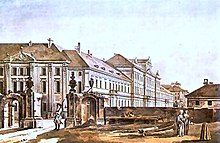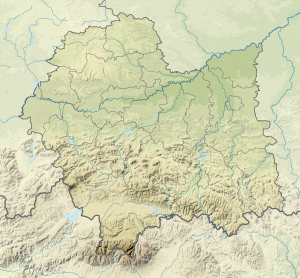Humanski Palace
| Humanski Palace | ||
|---|---|---|
|
Humanski Palace |
||
| Creation time : | 1725 | |
| Castle type : | palace | |
| Conservation status: | Reconstructed | |
| Place: | Warsaw | |
| Geographical location | 52 ° 14 '56 " N , 21 ° 0' 24" E | |
|
|
||



The Humanski Palace is a neo-classical , former city residence located at 15 Długa Street in Warsaw's inner city district . It is located at the intersection with Ulica Miodowa and is directly adjacent to the building of the Warsaw Collegium Nobilium . Its facade closes off Krasiński Square to the southeast. The square is also home to the Krasiński Palace and the Warsaw Uprising Monument .
history
The palace was built around 1725 for Jan Humański, a chancellor from Chełm and a Warsaw canon . A short time later, Humański donated the building to the Warsaw Piarist Order and the former residence was now used as part of the surrounding church and monastery complex of the monks. 1735 the facade was of to whom the Blessed Virgin Mary, Queen of Poland dedicated Field Cathedral of the Polish Army (Polish. Katedra polowa Wojska Polskiego pod wezwaniem Najświętszej Maryi Panny Królowej Polski ) adjacent palace visually adapted to the other monastery buildings. The building was now partially used as a school building for the newly founded Collegium Nobilium by Stanisław Konarski . During the construction of a larger new building for the school on Miodowa , the two buildings were interlocked in the 1740s. In the 1780s, Stanisław Zawadzki made further structural changes to the Humanski Palace as part of the redesign of the Collegium Nobilium .
As a result of the unsuccessful November Uprising of Polish patriots, the Russian occupation forces confiscated the cathedral and the adjoining monastery buildings in 1834. The cathedral was converted into an Orthodox church and the two adjoining buildings (the Humański Palace on the right) were adapted to the new exterior of the church. The design for it came from the architects Antonio Corazzi and Andrzej Gołoński .
Around 1850, the facade was made more objective and rental apartments were set up in the building. During the Warsaw Uprising in 1944, the former palace was destroyed to its foundations. Reconstruction took place in the early 1960s. The building with a classicistic design became the seat of the General Dean's Office of the Polish Army (Polish Generalny Dziekanat Wojska Polskiego ). On the courtyard side, the building was given a modern facade.
literature
- Julius A. Chroscicki and Andrzej Rottermund, Architectural Atlas of Warsaw , 1st edition, Arkady, Warsaw 1978, p. 60
Web links
- Information about the palace with historical photo at Warsawa1939.pl (in Polish)
- Długa. Nr 15: Pałacyk Humańskiego at Ulice Twojego Miasta (in Polish)

